Your Quick Guide to 8 Different Attribution Models
You’ve planned the best campaign you can. You’re going to do a great job executing. But how do you plan on measuring your success?
You’ve got to make sure you’ve chosen the right attribution model, of course. What’s attribution modeling? An attribution model is a set of rules that defines how you credit each conversion or sale at specific consumer touchpoints along the sales funnel.
How do you choose the right marketing attribution model that’s right for you?
Below you’ll find a quick guide to 8 different acquisition attribution models. Keep on reading and discover which attribution model is right for your campaigns.
1. Last Interaction or Last Click Model

The Last Interaction or Last Click Attribution model is a standard in most web analytics. In this model, all credit is assigned to the last event – whether is a click or any other type of interaction a customer had – just before conversion.
Historically, almost all conversions were attributed to the last click and Direct channel (traffic comprised mainly of visitors proactively seeking you out by entering your URL manually). The Last Click model is simple, and for that reason highly appealing. Its easy to track and doesn’t demand advanced technological assistance.
But, assigning all credit to only one channel is an oversimplification of the performance measurement and customer journey. Considering brands run marketing initiatives across multiple channels, single channel attribution fails to take all other traffic generation channels into consideration. For example, visitors may have been driven to your site and converted as a result of social media or by referral.
Last Click gives too much credit to the final event just before conversion, which may not necessarily be the final trigger for conversion. It ultimately undervalues all previous visitor interactions and decisions that pushes a visitor along the decision process towards conversion.
Finally, Last Click neglects to consider the impact of mobile. After all customers are now doing research on mobile well before they convert whether on desktop or mobile. Failure to credit other channels ultimately limit our ability as marketers to optimize each channel’s performance.
So now a day new technologies are quickly making Last Interaction or Last Click attribution modeling obsolete.
2. Last Non-Direct Click Model
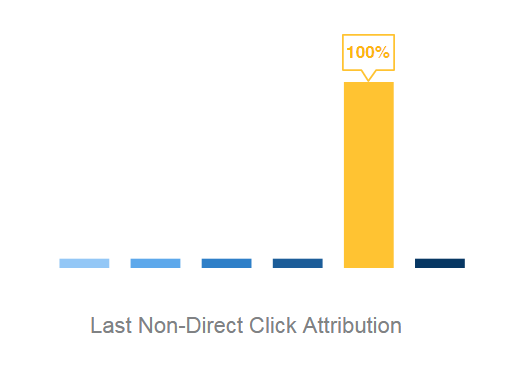
The Last Non-Direct Click Attribution model ignores all direct traffic and gives 100% credit of the conversion to the last channel the customer clicked through before converting. This can be any channel from email to social.
Last Non-Direct Click is a bit more useful than Last-Touch in that it has the potential to correctly give credit to the channel that drove the final conversion, while eliminating the need to deal with ‘Direct’ data which is often a catch-all for all traffic that isn’t properly filtered or tagged.
However, a big downfall of this model is that it completely undervalues Direct traffic, wherein a customer must remember your URL to visit your site and then convert, which in turn undervalues your branding efforts.
If a customer just received a well worded email campaign that prompted them to make a purchase, or they just got a promo code they’re now willing to use, why would any marketer want to give credit to the campaign they interacted with just before this one when it was this one that in fact prompted conversion? You wouldn’t, so most marketers have moved away from this model as well.
3. First Click Attribution Model
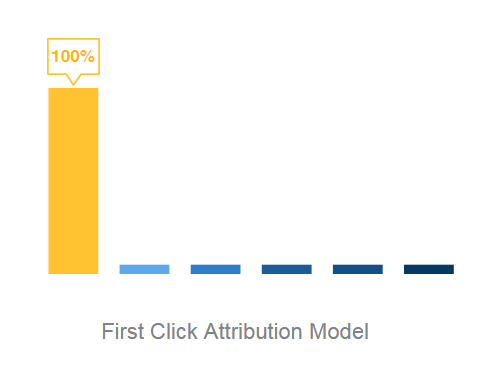 First Click or First Interaction attribution model assigns all credit to the first marketing event before conversion – it is the very opposite of the Last Click attribution model.
First Click or First Interaction attribution model assigns all credit to the first marketing event before conversion – it is the very opposite of the Last Click attribution model.
Again, its another attractive model because its so easy to use. And it does make sense, to an extent: you should definitely value the first customer interaction highly because without it, moving the customer along the decision making journey towards conversion is literally impossible.
But the First Click model doesn’t provide any actionable insight for marketers looking to optimize or measure their efforts. With Last Click attribution, at least we have some confidence in why and how that campaign triggered a conversion. First Click fails to show any data about the decision-making journey and gives too much credit to a single ad click.
4. Last Marketing Channel Touch Attribution

Last Marketing Channel Touch Attribution is channel specific. In other words, in this model, marketers would attribute the last known touch point specific to a channel to a conversion. For example, if you run Search you would use the Last AdWords Touch model. For Facebook, you would use the Last Facebook Touch and so forth.
But you can probably see the problem inherent with this model already: its incredibly biased towards its respective channels. You can easily overvalue the impact of each channel. If a visitor clicked a Search ad one day and then clicked a Facebook ad later in the week and then converted, each model will claim 100% credit for that conversion.
Rather than considering the model separately for each channel, aggregate them into a single report. This will give you a more holistic understanding of the multi-channel touchpoints that lead to a conversion.
The downside with this attribution model, however, is that you will see double or triple counted conversions which adds to your work load to further parse the conversion data.
5. Linear Attribution Model
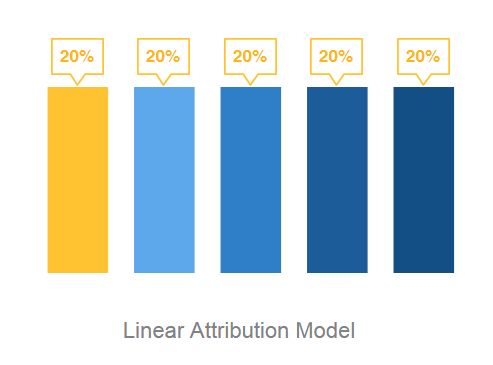
The Linear Attribution model gives each touchpoint along the conversion funnel, for example search, social, retargeting, direct, and email, equal credit for the final conversion.
This model is an improvement on all those we’ve discussed up to this point because it allows for credit to be applied to every single touchpoint along the buyer journey. It’s a simplified multi-touch attribution model.
That’s great! So what’s the problem now, you ask? Disproportionate weighting.
The Linear Attribution model fails to take into consideration the impact of all the other touch points which may have provided more value, and played a bigger role in triggering a conversion.
6. Time Decay Attribution
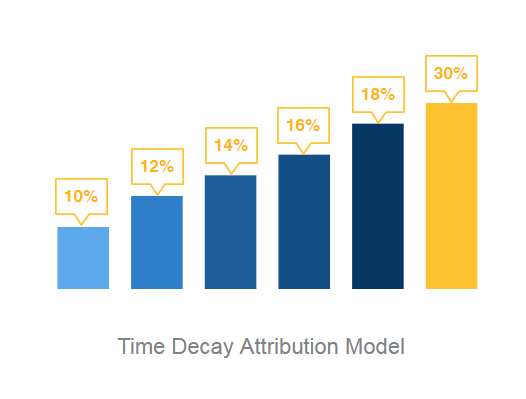
In the Time Decay attribution model, whichever touchpoint closest to the time when the sale or conversion took place receives the highest credit for the conversion. It functions under the assumption that the closer the interaction or click is to a conversion, the greater the impact that interaction had on the conversion.
The argument makes sense. And at least this is a multi-channel/multi-touch channel that also captures the data involved in the long decision making process.
One of its drawbacks, however, is that it may undervalue the heavy lifting that was done by marketing efforts higher up in the funnel which is always located farthest a way from the conversion point.
7. Position Based Attribution
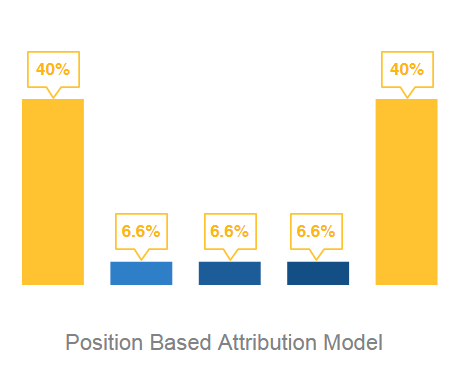
Typically, in the Position Based attribution model, the first interaction and the final interaction in the decision making journey before a conversion is given 40% credit for the conversion, respectively. The remaining 20% is distributed evenly between the other channels along the funnel, but such weighting can and should be adjusted.
The position Based model is a stronger attribution model that takes multiple touchpoints, and multiple channels into consideration. It credits two of the most important customer touchpoints: the first click or interaction (that which introduced the you to the customer) and the final interaction before conversion.
8. Algorithms Based (Custom) Attribution
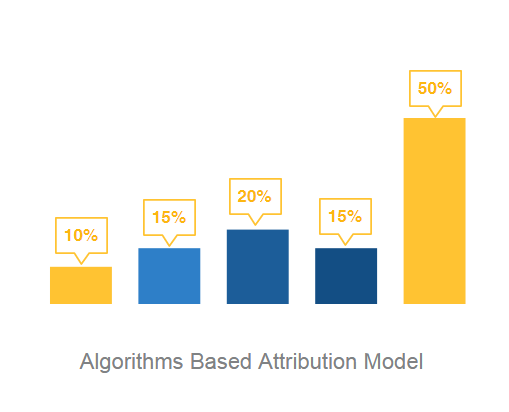
Algorithms or Custom built attribution models assigns credit for the conversion to each touchpoint based on its effectiveness.
This model requires advanced statistically modeling and continued optimization, based on your audience behaviour. It is in fact your existing customer data that will provide the foundations upon which to build your Algorithms attribution model, and understanding of which channel and which step in the decision making journey has the biggest impact on conversion.
The Algorithms attribution model is the most data-driven and provides the most comprehensive customer insight so marketers can identify non-traditional opportunities.
So what’s the final takeaway?
By today’s standards, we should all be steering clear of the First (only) or Last Interaction (only) attribution model. Choosing the right method for you will depend on your marketing needs and the required complexity of your marketing mix.
If it all seems too complicated, not to worry. Start with the simpler Time Decay and Position Based models, although again, avoid First and Last Click. To make attribution modeling of all your marketing campaigns accurate, all your campaigns must also be properly tagged and easily identified so you can give credit to where credit is due.
And finally, don’t just rely on conversion based attribution modeling. Consider other factors, including your CPA, not just conversions. How much does it cost you per acquisition per channel? Is the cost disproportionate to the value of the channel?
Taking all of your marketing efforts into consideration holistically will ultimately help you optimize for stronger campaigns, better targeting by channel and buying behaviour, and reduced spend for maximum performance.
Want to learn more? Connect with our team at sales@clearpier.com